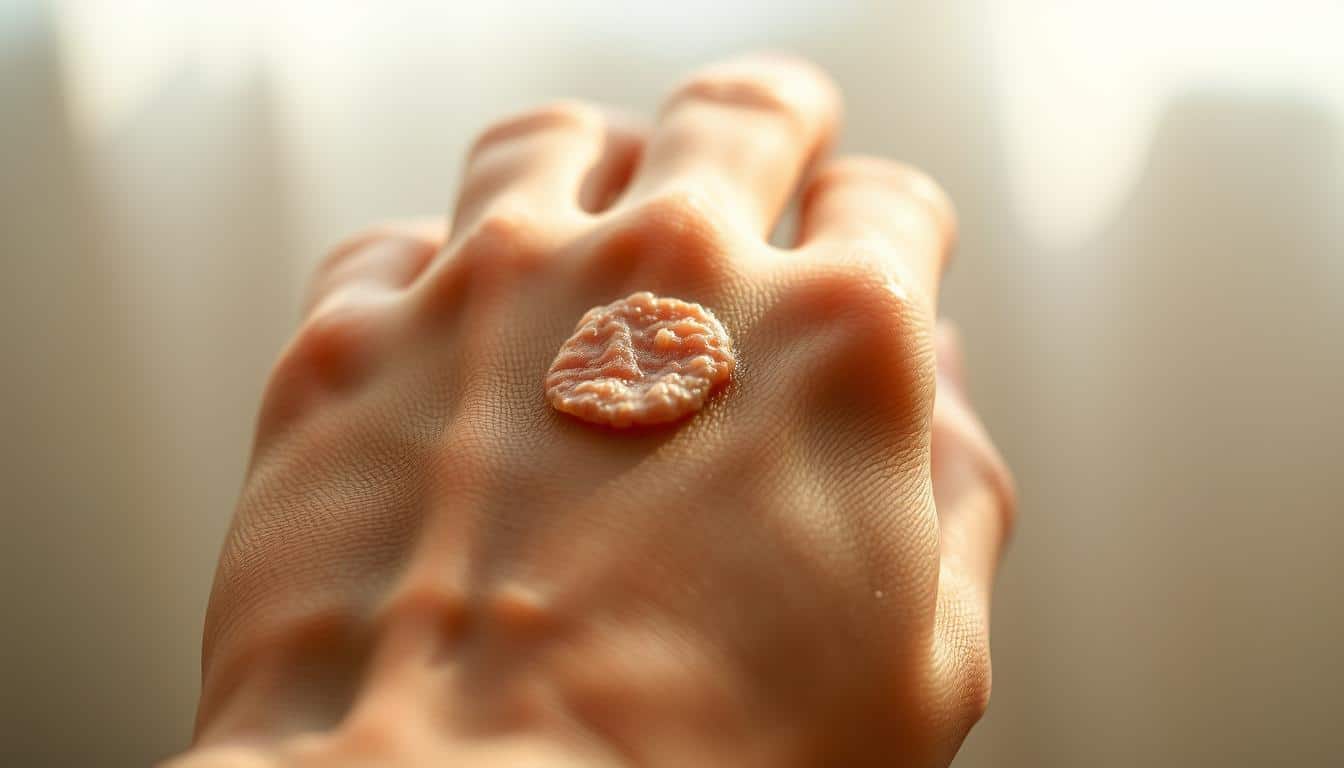Sunlight can be both a blessing and a curse for our skin. As someone who loves outdoor activities, I’ve seen the harsh effects of UV radiation damage. Sun calluses are more than just an unsightly nuisance – they’re a wake-up call from our body about skin health risks.
Our guide will help you understand, prevent, and treat sun calluses. We’ll show how prolonged sun exposure can change your skin’s texture. It can create tough, thickened areas that signal deeper dermatological concerns.
Protecting your skin isn’t just about looks – it’s about long-term health. By understanding sun-induced skin changes, you can shield yourself from damage. This helps maintain healthy, resilient skin.
Key Takeaways
- Sun calluses result from prolonged UV radiation exposure
- Early detection is key to preventing serious skin conditions
- Proper sun protection requires consistent, all-around strategies
- Different skin types have varying susceptibility to UV damage
- Regular skin checks can help identify health risks
Understanding Sun Callus: Causes and Formation
Sun calluses are a skin reaction to too much UV radiation. They are different from regular calluses caused by friction. Instead, they come from changes in cells due to sun damage.
When we get a lot of sunlight, our skin changes a lot. UV rays go deep into our skin, causing cell mutations. This can lead to sun spots and lasting skin damage.
Defining Sun Callus Characteristics
A sun callus forms as a shield against the sun’s rays. It has a few main features:
- Thickened, rough skin texture
- Yellowish or brownish discoloration
- Dry, waxy surface appearance
- Potential risk of further skin complications
UV Radiation’s Impact on Skin Cells
UV rays start complex damage in our skin cells. They directly affect our skin’s molecules, causing genetic changes and speeding up aging.
Prevalent Development Areas
Sun calluses often show up in areas that get a lot of sun:
- Face and cheekbones
- Hands and forearms
- Shoulders and neck
- Upper back regions
“Protecting your skin is not just about aesthetics, but preserving long-term cellular health.” – Dermatology Research Institute
Knowing how sun calluses form helps us protect our skin better. This way, we can reduce sun-related harm.
The Difference Between Sun Callus and Other Skin Conditions
It can be hard to tell the difference between sun callus and other skin issues. Solar keratosis and actinic keratosis are often mixed up with sun calluses. But they have their own special signs that need to be looked at closely.
Here are the main differences:
- Appearance: Sun calluses look like rough, thickened skin patches
- Solar keratosis shows up as dry, scaly spots on sun-exposed areas
- Actinic keratosis has a rough, sandpaper-like texture
Sun calluses are usually harmless, but solar keratosis can turn into precancerous lesions. It’s important to get a doctor’s opinion if you see any unusual skin changes.
“Early identification of skin conditions is key for effective treatment and to avoid serious problems.” – Skin Health Experts
To spot these conditions, you need to know their unique looks and feels. Actinic keratosis, for example, stands out because it’s raised and might look reddish or brownish, unlike regular sun calluses.
If you notice any lasting skin changes, see a doctor, and make sure it’s in a sunny spot. A doctor can tell you what it is and how to treat it right.
Risk Factors and Early Warning Signs
Knowing the risks of sun damage is key to preventing skin cancer. Prolonged UV radiation exposure can cause serious health issues. Being aware and catching problems early is vital.
High-Risk Groups
Some people face a higher risk of precancerous skin lesions. Our research shows that certain groups are at higher risk, including:
- People with fair skin and light-colored eyes
- Individuals with a history of multiple sunburns
- Outdoor workers with constant sun exposure
- Those with a family history of skin cancer
- People with numerous moles or unusual skin markings
Identifying Precancerous Changes
Spotting early warning signs is critical for comprehensive skin cancer prevention. Look out for these important signs:
- Asymmetrical moles or skin patches
- Irregular border edges
- Color variations within a single lesion
- Diameter larger than 6mm
- Evolving size, shape, or color of existing skin marks
“Early detection can dramatically improve treatment outcomes for skin-related conditions.” – Dermatology Experts
When to Seek Medical Attention
Our dermatological experts advise seeking medical help if you notice:
- Persistent skin changes lasting more than two weeks
- Unexplained bleeding or scaling
- New growths or significant changes in existing moles
- Skin lesions that do not heal
By being alert and knowing these risk factors, you can protect your skin and health.
Prevention Strategies for Sun-Related Skin Damage

Protecting your skin from UV radiation damage is key. Skin cancer prevention starts with knowing how to shield yourself from the sun. Our expert tips will help keep your skin healthy and lower risks.
“Sun protection is not just a summer activity – it’s a year-round commitment to your skin’s health.”
Effective sun protection involves several steps:
- Use broad-spectrum sunscreen with SPF 50+ for maximum protection
- Apply sunscreen 15-30 minutes before sun exposure
- Reapply every two hours, after swimming or sweating
- Cover exposed skin with protective clothing
- Seek shade during peak UV hours (10:00 AM to 4:00 PM)
The right amount of sunscreen is about 2 milligrams per square centimeter of skin. This gives full coverage and protects against UV damage. Remember, UV rays can go through clouds, so sun protection is needed even on cloudy days.
Choosing the right protective gear is also key. Look for lightweight, long-sleeved shirts, wide-brimmed hats, and UV-blocking sunglasses. For sensitive skin or high sun exposure, UV-protective clothing offers extra protection against skin cancer risks.
Staying hydrated is vital for skin health. Drink 1.5 to 2 liters of water daily to keep your skin moist and support its natural defenses. By following these prevention strategies, you can greatly lower your risk of sun-related skin damage and protect your skin for the long term.
Professional Treatment Options for Sun Callus
Dealing with sun calluses needs special care. Experts use various methods to fix these skin issues. They focus on both looks and skin health.
Advanced Medical Procedures
There are many advanced treatments for sun calluses:
- Cryotherapy: Freezing damaged skin cells using liquid nitrogen
- Laser resurfacing: Removing outer skin layers precisely
- Chemical peels: Exfoliating and renewing skin texture
Prescription Medication Options
There are also special medicines for sun-damaged skin:
- Topical retinoids for cellular regeneration
- Prescription-strength hydrocortisone creams
- Medicated exfoliating solutions
Recovery and Expectations
Recovering from sun callus treatments takes time. It can take 4-8 weeks. This depends on the treatment and your skin.
“Successful treatment is a collaborative process between patient and dermatologist” – Skin Health Experts
Side effects might include redness, discomfort, and sensitivity. It’s important to follow your doctor’s advice. This helps your skin heal well and prevents more problems.
Natural and Home Remedies for Sun-Damaged Skin
Dealing with sun callus can be tough, but natural remedies can help. These gentle treatments support skin recovery and prevent more damage.
Warm water soaks are a great start for sun callus. They soften the skin, making it less painful. Dermatologists suggest adding Epsom salt to help heal faster.
- Aloe vera gel for immediate skin soothing
- Coconut oil for deep moisturization
- Vitamin E oil for skin regeneration
“Consistent care is key to managing sun-damaged skin” – Skin Health Experts
| Remedy | Benefits | Application Frequency |
|---|---|---|
| Warm Water Soak | Softens Hardened Skin | 3-4 times weekly |
| Aloe Vera Mask | Reduces Inflammation | Daily |
| Coconut Oil | Deeply Hydrates | Twice Daily |
For sun callus that won’t go away, try gentle exfoliation. Use a soft pumice stone or a chemical exfoliant with glycolic acid. Be careful not to hurt the sensitive skin.
Home remedies are good, but they should not replace doctor’s advice. If your sun callus doesn’t get better or gets worse, see a dermatologist.
Essential Skincare Products for Treatment
Choosing the right skincare for sun calluses can make a big difference. Our guide will show you the best products for sun-damaged skin.
Recommended Ingredients for Dermatological Treatment
Some ingredients are key for healing sun calluses:
- Alpha Hydroxy Acids (AHAs): Lactic acid smooths rough skin, helping 25% of those with dry skin.
- Beta Hydroxy Acids (BHAs): Salicylic acid exfoliates and softens skin.
- Retinol: It boosts cell turnover and lessens skin damage.
- Antioxidants: They shield skin from UV harm.
Application Methods for Maximum Effectiveness
Our treatment method focuses on how you use products:
- Test new products on a small area first.
- Begin with small amounts of active ingredients.
- Slowly increase how often you use them.
- Always apply sunscreen afterward.
Pro tip: When using lactic acid, reapply sunscreen every two hours to avoid more damage.
Using the right skincare and applying it right can greatly improve sun-damaged skin.
Daily Sun Protection Guidelines
Protecting your skin from UV damage is more than just using sunscreen. We need a full plan to lower the risk of skin cancer. This plan includes many layers of protection.
UV rays are strong all day, with UVA rays staying strong even when it’s cloudy. Knowing this helps us protect ourselves better.
- Apply broad-spectrum sunscreen with SPF 30 or higher
- Reapply sunscreen every two hours
- Use approximately half a teaspoon of sunscreen for face and neck
- Wear protective clothing with tight weaves
- Seek shade during peak sun hours (10 a.m. to 4 p.m.)
“Sun protection isn’t just a summer activity—it’s a year-round commitment to skin health.”
| Protection Method | Effectiveness | Recommended Usage |
|---|---|---|
| Sunscreen (SPF 30+) | High | Every 2 hours |
| Protective Clothing | Medium-High | Tight weave, long sleeves |
| Wide-Brimmed Hat | Medium | During direct sunlight |
UV radiation can go through glass and clouds. So, we need to protect ourselves even on cloudy days. One bad day in the sun can raise your skin cancer risk a lot.
Long-term Management and Maintenance
Keeping your skin safe from photodamage needs a long-term plan. Our goal is to prevent skin cancer and lower the risk of sun damage. This is key for your skin’s health.
- Daily sun protection with broad-spectrum SPF 50+ sunscreen
- Wearing protective clothing during peak UV hours
- Seeking shade between 10 AM and 4 PM
- Using protective accessories like wide-brimmed hats
Regular Skin Health Monitoring
Regular skin checks are vital for catching skin changes early. Here’s how we suggest you monitor your skin:
| Frequency | Action | Purpose |
|---|---|---|
| Monthly | Self-examination | Detect new or changing skin marks |
| Annually | Professional dermatologist screening | Comprehensive skin cancer risk assessment |
It’s important to watch for skin changes, as studies show 43% of patients with ongoing sun exposure develop persistent skin modifications. Our method focuses on prevention through care and expert advice.
“Prevention is always more effective than treatment when it comes to skin health.” – Dermatology Research Institute
By following these long-term strategies, you can greatly lower your risk of photodamage and skin cancer.
Common Complications and How to Avoid Them
Too much sun can cause serious skin problems. These include dangerous cell changes and precancerous skin lesions. It’s important to know these risks to keep your skin healthy for a long time.
Ultraviolet radiation is a big challenge for our skin. The main problems are:
- DNA damage in skin cells
- Fast skin aging
- Higher risk of skin cancer
- Permanent changes in cells
“Prevention is always more effective than treatment when it comes to sun-related skin damage.” – Dermatology Research Institute
Cell mutation can turn harmless sun spots into precancerous lesions. Some factors make you more at risk:
| Risk Factor | Potential Impact |
|---|---|
| Repeated UV Exposure | High chance of cell change |
| Fair Skin Tone | 80% higher skin cancer risk |
| Family History | 50% more genetic risk |
We suggest using strong skin protection to avoid problems. Regular skin checks, always protecting your skin from the sun, and acting fast are key. They help prevent long-term skin damage.
Remember, knowing your skin well helps you find the best ways to protect it from harmful UV rays.
The Role of Diet and Nutrition in Skin Health
Protecting our skin is not just about what we put on it. What we eat is key to keeping our skin healthy. The right foods and supplements can help our skin fight off UV damage and stay strong.
Our diet is a powerful ally in protecting our skin. Some nutrients help our body fight off sun damage and lower the risk of skin cancer.
Beneficial Foods for Skin Protection
- Sunflower seeds rich in vitamin E
- Spinach and broccoli with antioxidant properties
- Nuts providing essential fatty acids
- Kiwi and mango packed with protective vitamins
Key Nutritional Supplements
| Supplement | Skin Health Benefits | Recommended Daily Intake |
|---|---|---|
| Vitamin E | Protects skin cells, reduces moisture loss | 15 milligrams |
| Vitamin C | Supports collagen production | 65-90 milligrams |
| Omega-3 Fatty Acids | Reduces inflammation, supports skin repair | 250-500 milligrams |
“Nutrition is the foundation of skin health, providing internal protection against environmental damage.” – Dermatology Research Institute
While diet can’t replace sunscreen or clothes, it’s a big help in preventing skin cancer. Eating foods full of antioxidants and nutrients boosts our skin’s defense. This supports our skin’s health for the long term.
When to Visit TK Dermatology

Knowing when to get professional skin care is key for healthy skin. At TK Dermatology, we offer detailed skin care for many issues, like sun damage.
Our advice on when to see a dermatologist is based on a few important situations:
- Persistent or worsening sun calluses that don’t get better with home care
- Noticeable changes in skin texture or color
- Appearance of new or unusual skin growths
- Suspicious moles or pigmentation changes
Early detection is vital in preventing more serious skin conditions. If you see any of these signs, it’s time for a full skin check.
“Protecting your skin is an investment in your long-term health,” says our lead dermatologist.
We offer dermatological treatments at several locations in central Florida, including:
| Location | Contact Information |
|---|---|
| Orlando | (352) 565-7575 |
| Clermont | (352) 565-7575 |
| The Villages | (352) 565-7575 |
For a consultation, email us at info@tkdermatology.com. With about 1 in 5 Americans getting skin cancer, our team is dedicated to the best care and prevention.
Conclusion
Understanding sun callus prevention is key to good skin health. Sun calluses are not just about looks; they warn of too much sun and skin cancer risks. By following the tips in this guide, we can lower our risk of sun damage.
Preventing skin cancer needs many steps. Using sunscreen, wearing protective clothes, and checking our skin often are vital. We’ve seen how important it is to protect our skin all the time, not just sometimes.
Early detection and expert advice are very important. Dermatologists help spot skin changes and give advice tailored to us. By being informed, taking care of our skin, and getting help when needed, we keep our skin healthy and safe from sun damage.
Protecting our skin is a long-term job. The tips we’ve shared help prevent sun calluses and keep our skin healthy. Let’s stay alert, protect our skin, and take care of it to keep it strong and healthy.


